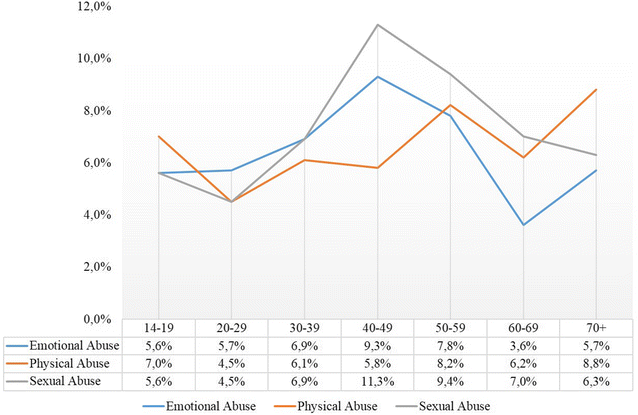Child maltreatment in Germany: prevalence rates in the general population
- PMID: 28974983
- PMCID: PMC5621113
- DOI: 10.1186/s13034-017-0185-0
Child maltreatment in Germany: prevalence rates in the general population
Abstract
Background: Child maltreatment and its consequences are considered a major public health problem. So far, there is only one study from Germany reporting prevalence rates on different types of maltreatment.
Methods: A representative sample of the German general population was examined for experiences of child maltreatment using the Childhood Trauma Questionnaire (CTQ) between September and November 2016. A total of 2510 (53.3% female) participants between 14 and 94 years (M = 48.8 years) were enrolled. Besides the CTQ, a range of sociodemographic information was collected. The interrelatedness of different types of maltreatment was examined using configuration analysis and predictors for maltreatment were identified by performing binary logistic regression analyses.
Results: Overall, 2.6% (f: 3.9%, m: 1.2%) of all participants reported severe emotional abuse, 3.3% (f: 3.4%, m: 3.3%) severe physical abuse, 2.3% (f: 3.7%, m: 0.7%) severe sexual abuse, 7.1% (f: 8.1%, m: 5.9%) severe emotional neglect and 9% (f: 9.2%, m: 8.9%) severe physical neglect. Women were more likely to report at least moderate sexual and emotional abuse than men. The largest difference between age groups was reported for physical neglect, with participants aged over 70 years reporting the highest rates. Participants who reported childhood maltreatment were more likely to be unemployed or have lower educational outcomes. The most common combination of maltreatment types were physical and emotional neglect, all five types of maltreatment combined and physical and emotional neglect and physical abuse combined.
Conclusions: Child maltreatment, especially physical neglect is common in the German population. Women seem to be at greater risk for sexual and emotional abuse than men. Knowledge about different types of maltreatment based on the Childhood Trauma Questionnaire (CTQ) can help to put findings of future studies into an epidemiological and societal context.
Keywords: Child abuse and neglect; Child maltreatment; Prevalence; Representative study.
Figures
References
-
- Weber S, Jud A, Landolt MA. Quality of life in maltreated children and adult survivors of child maltreatment: a systematic review. Qual Life Res. 2016;25(2):237–55. doi:10.1007/s11136-015-1085-5. - PubMed
LinkOut - more resources
Full Text Sources
Other Literature Sources



